
Monday, April 30, 2007
Blondheim Art Fun With Composition

Sunday, April 29, 2007
Blondheim Art Original Oil Painting
 18x24 inches
18x24 inchesoil on canvas
silver frame
Available at:
City Market Valdosta Georgia
Painters Tip
Workshop Preparation
I always provide a notebook for my workshop students based on the theme we are studying. I have been told that other teachers do not do this. What I suggest is that you make your own notebook before attending the workshop of your choice. The best notebooks are 3 ring binders from one to three inches wide, depending on how much information you wish to accumulate. For a long workshop like 5 to 7 days, use a large notebook. For a one to two day workshop, use the small.
Take about 20 sheets of index paper ( card Stock) and punch the holes inserting it into the notebook. This paper is wonderful for practice paintings and drawings. I always have specific exercises for my students to do and they use the index paper or small canvases for these assignments. You should also buy some lined notebook paper to add into the book for note taking.
These notebooks always have a clear protective cover , so you can make a cover sheet for that workshop with your name and the name of the teacher, the name of the workshop and date.
I encourage my students to use their notebooks over and over again after the workshop. I have one of my own for each workshop I teach and I continue to add to it with new information and research. You can do the same.
My flower painting workshop notebook also has dried flowers from my flower press added a few at a time. I glue the blossoms and stems to index paper and slip the paper into one of the clear plastic paper protectors with the holes in it. Those are inserted into the back of my notebook. I can use them to draw or paint whenever I wish.
Essentially, these notebooks become journals about painting from theme to theme with pages added in as I continue to grow as an artist.
I sell my workshop notebooks on my web site on the artist resources page. They are full of information and exercises for painting related to specific topics.Saturday, April 28, 2007
Blondheim Art Original Landscape Painting
 12x16 inches
12x16 inchesoil on panel
SOLD
See more paintings HERE
Painters Tip
I recently talked with an artist who was lamenting the fact that she had no privacy in her studio space at home.
I suggest looking at the warehouse district wherever you live. I have had two or three different warehouse studios in various stages of disrepair, from pretty good to ramshackle. They were all cheap. I remember one particularly. It was in an old cigar factory in Tampa Florida. I was a starving art student at the time and it was a huge space in the third floor. There were other art students there and plywood partitions between the spaces. It was a great space but hot as sin in the summer and freezing cold in the winter. The pigeons dropped in each day so it smelled like guano. Please understand that I was 20 years old at the time and thought of myself in a garret in Paris. It was all so romantic.
These days I am in a cozy studio behind my house with AC, carpet and heat.
You may want to consider one of the new storage spaces which are climate controlled. A few shop lights added and a roll out rug and you have a pretty nice studio space with AC and Heat with a nice big door.
Another possibility is sharing a commercial storefront space with other painters. It would be fairly easy to partition off three or four spaces in a small storefront. The advantage is that you have front window space to display your work and public accessibility for your work.
Sometimes gallery dealers have some storeroom space that can be rented out or traded for work in the gallery.
Don't forget rural farms and barns. Look around. Possibilities for studios are everywhere.
Friday, April 27, 2007
Blondheim Art original Seascape Cape San Blas

Thursday, April 26, 2007
Blondheim Art Forgotten Coast Cape San Blas Dunes

Wednesday, April 25, 2007
Blondheim Art Original Landscape Painting
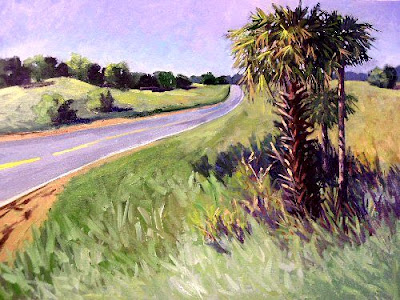
Tuesday, April 24, 2007
Blondheim Art Original Painting Epcot Center Flower and Garden Festival 2007
 United Kingdom Trees
United Kingdom Trees8x10 inches
acrylic on panel
500.00
silver or gold frame
Purchase HERE
Painters Tip
In my opinion, the three most important areas of study in painting are color, values and composition. I call them the big three. We all have limited time for painting. I believe concentrating on those three areas will bring you the best results. This is no small task. I have been studying the big three for many many years and I have much to learn. Composition and the design elements are a lifetime study for most painters and should be. Composition is the alpha dog of the trio.
I promise if you will take the time to study the design elements and composition your work will improve. Use your painting study time wisely. Focus on the big three and you can't go wrong.
Monday, April 23, 2007
Blondheim Art Rabbit Hill Farm Trees Original Oil Painting
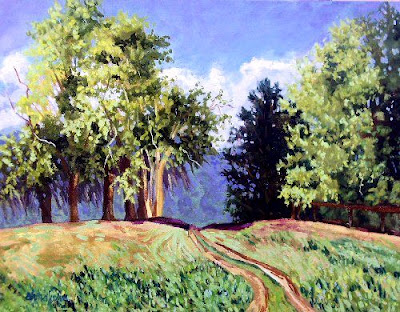
acrylic on panel
gold or silver frame
Available at http://www.paddiwhack.com
Painters Tip
When placing major elements in your landscape , think about intervals between elements and shapes and sizes. Try not to line everything up like ducks in a row. Vary the trunk lengths and widths, as well as the color temperatures in the tree canopies. As you can see in the above painting, the trunks vary in color as well as the canopies to add interest as the eye moves around the painting. Overlapping trees, by flattening and lessening the intensity, helps to push areas back into the distance, so that one has a sense of space.
Blondheim Art Epcot Center Flower and Garden Festival 2007
 Trellis
TrellisUnited Kingdom Pavilion
Epcot Center
8x10 inches
acrylic on panel
Gold or Silver Frame
Purchase Here: http://www.lindablondheim.com
Artist Journal
I'm home for a week or two between trips. To read about my Epcot Adventure go to:
Painters Tip
A good painting whether abstract or representational needs to be about something. Without a definable subject it becomes boring and incomplete. A painting can evoke mood, emotion or make a statement via the subject you choose. Every painting needs a dominant feature to stabilize and balance the composition, whether recognisable or not. Think of the subject as a magnet for the viewer. It should be compelling in some way.
Tuesday, April 17, 2007
East Coast Dunes

10x10 inches
oil on canvas
Painters Journal
New Workshop
Plein Air COLOR
Let’s Study Color on Location
November 24, 2007
Paynes Prairie State Park
9-5 PM
Beverages and Snacks included
Bring a brown bag lunch
65.00
Park Fee 4.00
This workshop will focus on color including technical information about color, values and color, mood of color, limited palettes, expanded palettes and color mixing. Notebooks will be provided.
Contact: lindablondheim12@hotmail.com
I will be away for a few days starting tomorrow. I will be painting at the Epcot Center Flower and Garden Festival Friday through Sunday in the United Kingdom pavilion. I'll have some photos and stories for you on Monday. If you are going to the festival, stop and say hello.
Painters Tip
My workshop sponsor Jack Richeson & Co. Jack Richeson & Co. Fine Art Materials sells these terrific little palettes.
Monday, April 16, 2007
Blondheim Art Orignal Landscape Palms Taylor Creek
 12x16 inches
12x16 inchesacrylic on panel
gold or silver frame
800.00
Purchase HERE
Painters Tip
Loosen up with Brush Warm Ups
When you get in the studio start with a brushwork warm up
When holding your brush avoid holding your brush like a pencil too close to the bristles. Oil brushes are made long for a reason so that you can paint further away from the canvas. Practice holding the brush toward the middle and end of the handle. Change hands once in a while.
Practice :
long strokes
short choppy strokes
diagonal
circle
edge of brush
flat of brush
painting from the bottom up
from the top down
left to right
right to left
washy fluid paint
thick paint
Perpendicular strokes
strokes with the brush parallel to your canvas
After you do these silly little things, get on with the serious business of painting.
Sunday, April 15, 2007
Blondheim Art Original Landscape Painting

Saturday, April 14, 2007
Blondheim Art Indian Pass Palms
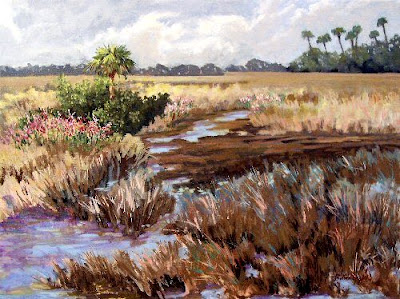
Friday, April 13, 2007
Blondheim Art Original Landscape Painting On the Beach

Thursday, April 12, 2007
Blondheim Art Original Oil Painting Landscape

Wednesday, April 11, 2007
Blondheim Art Florida Marsh Original Painting
 6x9 inches
6x9 inchesacrylic on panel
350.00
silver frame
Purchase Here
Painters Tip
Enlarging Photos
Gridding
There are a couple of handy ways to enlarge a photograph. My favorite is by the grid method. Draw a grid on your photo or a copy of your photo if you don't want to ruin the photo. Then make the identical grid pattern on your canvas. Then it is just a matter of filling in each square accurately. Look at the squares as individual contour drawings, not as a definable objects. Pay attention to positive and negative space, curves angles or line placement within the squares. At the end, you have enlarged the photo fairly easily and it is a fun project. As a bonus, you may end up with some pretty cool abstract painting ideas.
Opaque Projector
The second method is by opaque projector. This goes much faster than the grid method but you will need to be aware that if you don't have straight angles it can look distorted. I would suggest that you actually hang the canvas straight on the wall before starting, to minimize the distortion.
Free Hand
Of course, you can free hand too. This takes quite a while and many corrections. I like to draw it out on paper, make my corrections and then hold the paper up to a window and use clean paper and pencil to redraw a neater version. Then you can flip it over, use pressure on the backside to follow the lines, flip again right side up and draw on your canvas. The faint lines will show.
They all work.
Tuesday, April 10, 2007
Blondheim Art Original Paintings River
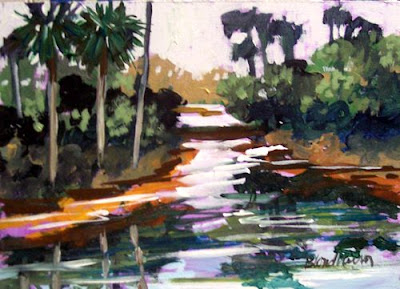
Monday, April 09, 2007
Blondheim Art St Marks Lighthouse Florida Panhandle

Sunday, April 08, 2007
Blondheim Art Original Painting Cross Creek Florida

12x16 inches
acrylic on panel
800.00
gold or silver frame
Purchase HERE
Painters Tip

When you are painting objects like towers or light houses it is important to make them pretty even and straight. It will help you to first draw a vertical rectangle as a guide. You can split the rectangle vertically so that you know the middle and the edges and then make adjustments in the shape. It will still be centered. When you get the outline correct, You can paint over the rectangular shape which was your guide. I like to carry a little 6 inch ruler in my paint box so that when I go out on location I can make the corrections with it when painting architecture. My example was quickly done without a ruler. If I were doing it to get an accurate painting, I would definitely use a small t-square or ruler.
Saturday, April 07, 2007
Blondheim Art Field of Palms
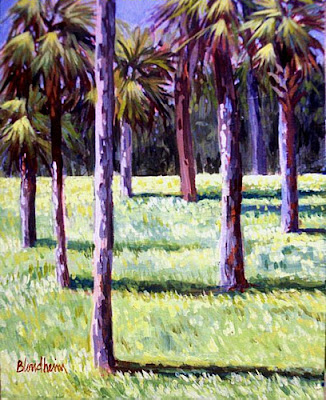
8x10 inches
acrylic on panel
gold or silver frame
500.00
Purchase HERE
Painters Tip
Substitutes for Blending
I used the above painting to illustrate to my workshop students several brush work options for using acrylics. Acrylics don't blend all that easily, so I have learned to use scumbling, stippling and short choppy brush strokes to simulate blending.
They work quite well in various combinations. The grasses were all done with short choppy brush strokes and stippling layers of color. It is hard to see in a digital image. The trunks were scumbled and stippled and most of the background trees were layered ith multiple short brush strokes and stippling. Then the background was thinly glazed with several layers to make the trees recede.
The interesting thing is that these techniques have made me a better oil painter too. I don't do nearly as much blending with oils as I used to. I have stolen some of the methods I learned from acrylics and am using them in my oil paintings. Way Cool.
Friday, April 06, 2007
Blondheim Art Original Painting Palms

8x10 inches
acrylic on panel
gold or silver frame
500.00
Purchase HERE
Painters Journal
I'm posting Saturday's Blog on Friday because I am teaching a workshop all day tomorrow.
New on My Web Site
I receive emails all the time from artists who wish they could take my workshops but live too far away. For each of my workshops I make a three ring binder full of exercises and materials related to the theme of study. You can now purchase these workshop notebooks here at my web site. The notebooks have a series of exercises which you can do over and over again and keep in your notebook. Now you can do your own workshop at home when it is convenient.
The notebooks are 40.00 with 7.00 shipping USPS Priority Mail.
http://lindablondheim.com/publications.php
Painters Tip
Painting with Neutrals
Think of your neutrals as warm or cool. You can have a definite bias in your grays toward warm of cool, depending on which primary you emphasize. Let's say you want to make a neutral and you have Cadmium Red Light, French Ultramarine Blue,Cad medium Yellow and Titanium White. This will be a warmer neutral than a combination of Alizarin Crimson, Cadmium Yellow Lemon and Thalo Blue. You will have a warmer neutral moving toward brown with more red. You will have a cooler neutral moving toward blue with more blue added. You can control the cold or warm neutrals by the proportion of any combinations you use.
Practice making neutrals with your split primary palette. Use cool red/warm red, cool blue/warm blue, and cool yellow/warm yellow, mixing neutrals with each. You Will soon see that there are many possibilities and subtle neutrals to choose from.
Let's say you wish to use black and white for gray. No problem with that. You can add a bit of cool blue or red to enhance it, or go to warm red or blue to swing it back toward a warmer gray.
What I love to do best with neutrals is use them next to pure chroma. Neutrals make color pop better than any other color because there is such a great contrast visually between the neutral and the color it is next to.
Thursday, April 05, 2007
Blondheim Art Contrast Exercise
Wednesday, April 04, 2007
Blondheim Art Original acrylic painting Vineyard

6x8 inches
gold frame
acrylic on panel
300.00
Purchase HERE
Painters Tip
Drawing Makes Good Painting
How many of you painters make it a habit of drawing each day? If you are not, you should be. Drawing is fundamental to all good art in my opinion. Drawing teaches you about edge work, form, value, light, proportion and composition just to name a few of it's benefits.
Get into the habit of drawing for even five minutes a day and your painting will improve. Whenever you come up with an idea for a painting, do the composition and value study in pencil first. Make a series of thumbnail drawings for your composition and pick the best two out of the bunch. Use those sketches to make your painting composition and it will be better than anything you would have thrown on the canvas.
Drawing can also help you overcome fears about painting subjects. Because it is just a cheap piece of paper and a pencil, you won't mind messing it up and making mistakes. Some people have real hang ups about wasting paint and canvas. The drawings will help you to overcome that intimidation. You will have more self confidence as a painter if you learn to draw competently. No one has to see your sketches. I will tell you right here that many of mine are terrible, but I am always learning from the process.
Get several small sketchbooks or pads of blank paper, or use a three ring binder like I do. I like to draw on index paper and punch the paper, inserting it into my binders. Since these drawings are study, I don't need to worry about archival issues.
I suggest that you keep a sketch pad/pencil in your car, in the kitchen, the table by your easy chair, and your night stand. Pick them up and do quick drawings a few times a day or even once a day. Draw whatever you see, including figures, furniture, objects, and the landscape from you car window. Date the drawings and you will be surprised to see good progress in your work both in the book and on canvas after a few months.
Tuesday, April 03, 2007
Blondheim Art Acrylic or Oil Warm Up Exercise

Painters Tip
I do these great little exercises to warm up for painting. The lines up and down are with watered down paint. The lines from left to right are paint with acrylic glazing medium. I then mix the paint with gloss gel medium and do the swatches, using the stripes of color mixed. In other words, whatever lines form the square I'm going to paint, have those colors mixed together for the swatch of color.
The purpose of this exercise is doing brushwork, mixing harmonic colors, practicing glazing and different thicknesses of paint, and using multiple mediums. It goes pretty quickly and is a good way to start the painting session.
I use index paper and punch holes in it to save in my painting journal.
I sometimes change palettes to practice variety, but the key is to use a limited palette.
My palette for this exercise was the minimal palette I sometimes use on location:
Cadmium Red Light
French Ultramarine Blue
Cadmium Yellow Lemon
Ivory Black
I left off the white that I usually use.
This exercise works equally well for oil paints and oil mediums. I use the same index paper for both but of course, I let the oil paint dry for a few days before putting it in my notebook.
Monday, April 02, 2007
Blondheim Art Original Landscape Painting

Evinston Flowers
12x16 inches
oil on panel
800.00
Gold Frame
Purchase HERE
Painting with Kids
I raised two daughters alone while working as an artist and caterer, so I understand how difficult it can be to manage small children and a painting career.
Here are a few suggestions:
1. If you have a spouse, good friend or relative who would take the kids for one hour a week that would be your first solution.
2. If you live near an urban area with large churches, they have wonderful day care sessions in the morning for 2 to 4 hours.
3. Hire a student to come in and sit with the kids for a couple of hours a week. You will not have to waste time getting them ready to go out. The sitter can stay at your place with the kids while you paint.
4. Set up play dates with other children and moms and take turns having kids over for play time.
5. Paint late at night after the kids are in bed.
6. Set up art stations around your studio space for the children. Station 1- Play Dough or clay. Station 2- markers and paper Station 3- tempera paints Station 4- colored chalk with a blackboard. Station 5- watercolor paints and paper Station 6- art puzzles Station 7- Legos for sculpture.
Only allow them to do these stations while Mommy is painting. No other time. Set a timer for 15 minutes at each station and then they move to the next. This will become a treat for them and a special time to be a real artist like Mommy. Have a VCR/DVD player in your studio. After they finish their stations they may watch a movie. Make it a special reward time for them. Never let them use these stations unless you are painting. That way it will become a routine for everyone to do art together. You will be able to paint while they are entertained in the same room.
7. Get ito the habit of saying "Mommy is going to paint now. That means you must not talk to mommy for 5 minutes". Set a timer and if they can be quiet and not talk to you for five minutes give them a small reward. You will be able to eventually have them doing art with you in a quiet space for quite some time as you increase the timer a little each week. By the time my girls were four or five, they knew that if Mommy was at the easel, they were not to talk to her. They could be in the studio with me doing things or watching movies but they knew not to talk to me while I was working at the easel.
8. Make sure that you have your own painting space ready to use in an instant. You don't want to waste any precious time setting up the easel and painting supplies. If you make it a habit to paint for at least a few minutes each day or each week, it will become a habit for you. If you are concerned about toxisity, you will need to have a studio set up that can be locked. If that is not possible, then switch to colored pencil or child safe watercolor until they are old enough to understand that paints are off limits. If they have their own fun art stations, they will be less interested in yours.
Making art a part of family activities is a wonderful way to teach children about humanities and culture as well as fine art.
I teach family art camps, for children and parents to come together and spend the day painting. You can do the same thing for your own family.
Sunday, April 01, 2007
Blondheim Art Florida Cattle Original Painting

8x10 inches
acrylic on panel
Gold Frame
500.00
Purchase HERE
Painters Tip
Studio Visits
I'm very pleased to have a studio visit from a person from Michigan today. She saw my web site and wants to have a personal visit while she is in the area on vacation.
It is always exciting to have people come from far away. She is going to go out of her way to visit my studio and that is an honor.
I always do a little research on visitors if I have any information about them. It's nice to know what they do and what they are interested in seeing before they come. I looked up her web site and read about her. I just Google searched her name.
I spent yesterday spiffing up the studio and putting things in closets, pulling out paintings and arranging them attractively around the studio. I also put out my guest book and a pen and my brochures and business cards.
Last night I made a quick coffee cake and got some juice and soft drinks to put in my mini fridge. I want her to feel comfortable, like a guest in my home. I spend most of my time in my studio when I am not traveling, so it really is my home. It desn't really matter whether she decides to buy a painting or not. What is important is the connection we make. She will have a good or bad impression by the way she is treated. I will do my best to give her a wonderful experience. It is always wonderful to meet a new friend.
Consider studio visits to be a welcome event, not a chore. Take a bit of time to prepare. Relax and enjoy the time with visitors and make them welcome. Do not concern yourself with selling paintings. Sell yourself instead, and spend time enjoying the company. Find out something about your guests and you will discover new friendships.




